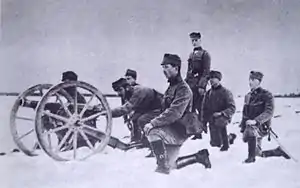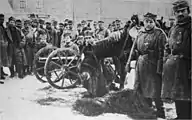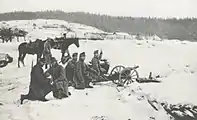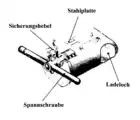7 cm Gebirgsgeschütz M 75
The 7 cm Gebirgsgeschütz M 75 was a mountain gun used by Austria-Hungary during World War I. Despite its 7 cm designation it actually fired a 66 mm (2.6 in) projectile. The Austro-Hungarian Army rounded up to the nearest centimeter for their designations. It was obsolete upon introduction as it had a bronze barrel and no recoil mechanism so it had to be relaid after every shot. The gun had an early form of Krupp horizontal sliding-block breech and it fired separate-loading, bagged charges and projectiles. Due to its low profile, its breech could recoil into the ground so its angle of elevation was restricted which was a significant handicap for a mountain gun which needed high angles of elevation. For transport, the Gebirgsgeschütz M 75 could be broken down into two loads.[1]
| 7 cm Gebirgsgeschütz M 75 | |
|---|---|
 A Gebirgsgeschütz M 75 in action with the Polish Legion. | |
| Type | Mountain gun |
| Place of origin | |
| Service history | |
| In service | 1875-1918 |
| Used by | Austria-Hungary |
| Wars | World War I |
| Production history | |
| Designer | Škoda |
| Designed | 1875 |
| Manufacturer | Škoda |
| Produced | 1875[1] |
| Specifications | |
| Mass | 199 kg (439 lb) |
| Barrel length | 990 mm (3 ft 3 in) L/15 |
| Width | 737 mm (2 ft 5 in) |
| Height | 644 mm (2 ft 1 in) |
| Crew | 4[1] |
| Shell | Separate-loading, bagged charges and projectiles |
| Shell weight | Shrapnel: 3 kg (6 lb 10 oz) HE: 3 kg (6 lb 10 oz) Canister: 2 kg (4 lb 7 oz) |
| Caliber | 66 mm (2.6 in) |
| Breech | Horizontal sliding-block breech[1] |
| Recoil | None |
| Carriage | Box trail |
| Elevation | -10° to +24° |
| Traverse | None |
| Rate of fire | 6 rpm |
| Muzzle velocity | Full charge: 291 m/s (950 ft/s) Reduced charge: 181 m/s (590 ft/s) |
| Maximum firing range | HE: 3 km (2 mi) Shrapnel: 1.8 km (1 mi)[1] |
| Wikimedia Commons has media related to 7 cm M.75. |
Photo Gallery
.jpg.webp)


 The M 75's breech block.
The M 75's breech block.